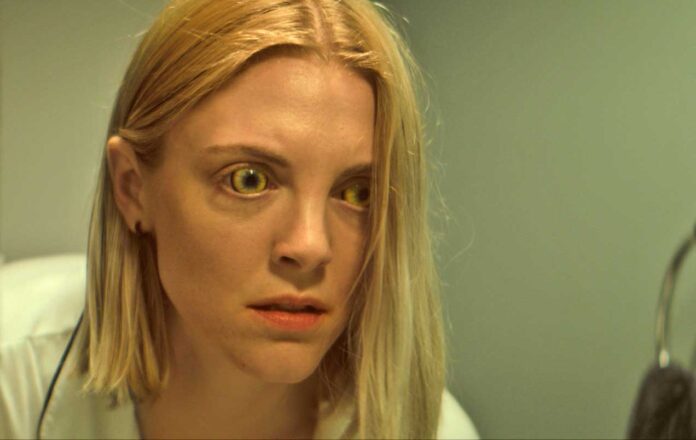The Canadian horror film, “Bloodthirsty,” directed by Amelia Moses, and available on demand April 23, opens with the vivid image of Grey (Lauren Beatty) feeding hungrily — and messily — on an unidentified corpse. Then she wakes up from a dream. It is an unsettling moment for Grey, but one she is not unfamiliar with. Grey suffers from hallucinations and takes medication for her condition. Her concerned doctor (Michael Ironside) suggests cognitive behavior therapy.
Instead, Grey, a lesbian indie singer/songwriter, chooses to deal with her demons through art therapy. She has been approached by Vaughn (Greg Bryk), a music producer, who wants to record her next album. Grey and her girlfriend Charlie (Katharine King So), a painter, head out to Vaughn’s remote home to get to work. However, Charlie is skeptical — Vaughn was accused of murdering his wife Greta — but Grey gives him the benefit of the doubt, indicating that he was acquitted.
As the young women settle in at Vaughn’s home, “Bloodthirsty” starts to get creepy. Grey falls under the spell of Vaughn, who is like a Svengali, urging her to go deeper for her music. (Her songs, which are by the film’s co-writer, Lowell, are, alas, not very catchy). Charlie thinks Vaughn is a psycho. Grey claims he is helping her. The women’s relationship starts to get strained. Meanwhile, Grey’s relationship with Vaughn takes on aspects of Stockholm Syndrome. Charlie repeatedly insists they leave, but Gray doubles down on her need to finish the album.
Viewers will likely sympathize with Charlie, who is the film’s sole voice of reason. Unfortunately, she is often ignored. The disquieting bond that develops between Grey and Vaughn may ratchet up the tension in the film, but it also works against it. Grey barely questions Vaughn’s curious behavior — as when he sniffs her during a rehearsal session and tells her, “I can smell it all over you — something primal.” Moreover, when Vaughn takes Grey’s pills away, Charlie confronts her girlfriend about it. Grey demurs, “I don’t think I need them.”
Grey was certainly a more confident woman before meeting Vaughn, as evidenced by her handling a nosy reporter (Jesse Gervais) at a photo shoot. But once under Vaughn’s influence, she changes. Whereas Grey is vegan, she takes a bite (or two) of Vaughn’s steak at a private dinner. Where she previously refused alcohol, she swallows the absinthe Vaughn serves her. She unexpectedly attacks Vaughn after sipping the cocktail, which does not disturb him so much as leads him to encourage her thirst for blood.
“Bloodthirsty” holds off on the real horror and killings until late in the film, when Grey is drawing blood during sex with Charlie, and later murdering mice and rabbits. (She also can’t resist drinking the juice pooling a plate of meat in the fridge). Charlie tells Grey she is “not herself” anymore but Grey begs to differ. “I am myself,” she avers menacingly. When Grey makes a not unexpected physical transformation hinted at throughout the film, it is effective but underwhelming. (The sound design during this sequence is impressive).
Moses does create a sense of dread with bloody images, but too much of “Bloodthirsty” feels slight. There is a strong emphasis on mood, which is appropriate for psychological horror, but the slow-burn plotting feels lazy. A line Grey has about her dead mother “speaking to her through music” results in an unsurprising reveal later. When Vaughn suggests that Grey record Greta’s unfinished song, it seems forced. (Although that song is actually quite good). The lack of substance can be frustrating, though. If there is a metaphor for Grey’s behavior and transformation, it is as ambiguous as all of her hallucinations.
Lauren Beatty captures Grey’s discomfort well, but her character is rarely likeable, which is a big drawback. It is difficult to root for Grey even when she is put in an untenable position. In contrast, Greg Bryk carries the film with his performance. He repeatedly makes Vaughn both seductive and sinister.
The film wisely eschews creating sexual tension between Grey and Vaughn, and “Bloodthirsty” does deserve credit for putting lesbian characters in the center of the story and not making any of the drama about their sexuality. That said, when Charlie urges Grey to leave for the umpteenth time, viewers will be ready to go with her.
“Bloodthirsty” could have been more effective if it had been better developed. There is a germ of a good story here, but it is not told well. Too much of the film feels contrived, as when a hitchhiker (Jayce McKenzie) is introduced only to be quickly dispatched.
It is always disappointing when a horror film whets an appetite for terror and gore and ends up leaving viewers wanting more. “Bloodthirsty” is ultimately unsatisfying.

